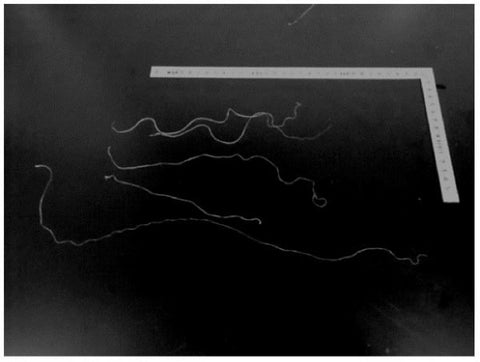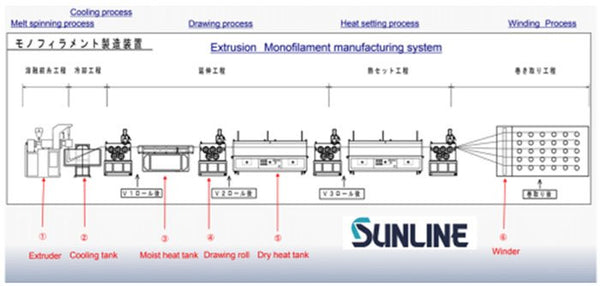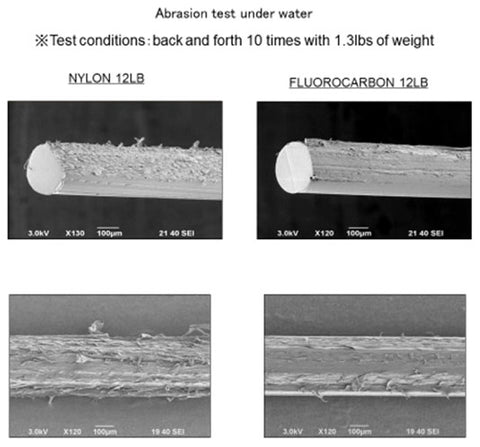History of Fishing Line and Fluorocarbon Fishing Line

The Earliest Beginnings
Angling dates back thousands of years, with archeologists discovering ancient Egyptian art depicting fishermen using rod, line, and hook from the year 2000 B.C. The time period from 1603 to 1868 saw the development of natural lines from several different natural products.
The first natural line was made from sericterium (silk glands). The silk gland fibers were spun into lines to create the first natural fishing lines. This natural line had ideal characteristics of moderate stiffness and good relative transparency. The greatest limitations were the time required to make the line and the maximum length that could be produced was just over 8 feet.
The development and production of natural lines in this manner were very innovative at the time. The line made this way during this period was more expensive than gold for the same weight.
Moths would create silkworm nests, and line makers would collect those nests to separate individual silk gland fibers. These individual silk glands are called sericterium.


After soaking in acid, the sericterium was removed and stretched to create the line.

The Introduction of Artificial Fishing Line
In 1884, an "artificial" line was invented in France using twisted silk mixed with resin and chemicals. This represented the first line not made from all-natural fibers.In 1937, Warren Carrosas of DuPont succeeded in synthesizing the world’s first nylon (66 nylon) line. This new synthetic line was a fiber made of water, air and coal, with very high strength and thin as spider silk. Many anglers today commonly refer to nylon lines as monofilament. Technically, any line made with one fiber is a mono or single filament, but many anglers refer to all nylon lines as monofilament.
In 1939, Toyo Rayon (now Toray) succeeded in synthesizing nylon 66 in Japan. In the same year, the company succeeded in producing nylon 66 filament by dry spinning. However, the synthesis required concentrated nitric acid and the equipment could not withstand the acid during production.
In 1942, Toray named all synthetic lines polyamides, including nylon 6, “Amiran”. In 1943, Toray received a National Order “Research on the synthesis of raw materials for polyamide-based synthetic fibers and spinning from polymers”, but they discontinued production of synthetic line due to intensifying conditions from World War II in 1944.
The launch of the first polyester braided line for hand fishing took place in 1953 from company YGK. YGK continued the innovation of braided lines with the launch of braided polyester line for reels in 1970.
The Introduction of Fluorocarbon Fishing Line
The first fluorocarbon fishing line was a carbon compound "vinylidene fluoride resin" fluorocarbon. Kureha started production in 1970, and in 1971, Japan's first fluorocarbon leader "Seaguar" debuted. It is manufactured using fluorine atoms contained in fluorite. The raw material is a pelletized PVDF monomer from the extracted fluorine compound. These early fluorocarbon lines were originally used as leader material only, primarily in saltwater.
Sunline was established in 1977 with a focus to create the highest quality line and quickly rose to prominence in the Japanese market. In 1981, Sunline launched Kyokurin Hard, the first line to use waterproof hard resin coating.
Soon after, in 1984, Powerd was launched in the Japanese market. Powerd was the first line launched with diameter and knot strength indications listed for the lines. This allowed anglers to know for the first time the actual diameter of the line and comparable tensile strength.
Japanese firm Toyobo and Dutch company DSM succeeded in making high density polyethylene filament in 1988. They created the foundational raw materials used in the production of today’s modern braided lines. Sunline’s first braided line product, Deep One launched in 1992.
Fluorocarbon Line in the 1990's
Around 1990, bass fishermen began to use fluorocarbon leaders as the mainline on spinning and bait casting reels. Anglers were looking to capitalize on the characteristics of lower visibility and higher abrasion resistance that they liked in the leaders to use as their main lines full time. Fluorocarbon also provided greater sensitivity for a main line due to it having less stretch than nylon.
In 1991, Sunline opened a new factory featuring increased technology and a much larger production output per year. In 1992, Sunline started production of Sunline branded fluorocarbon lines, and soon after their first braided line product, Deep One, was launched the same year.
These first fluorocarbon lines were tested many times in the lab and on the water with Sunline's pro angling team. Multiple prototypes were created to ensure the final finished product would meet anglers' needs.
Production grew at a rapid pace as the demand for fluorocarbon lines began to build in many markets. In 1993, Sunline launched Tornado, their first fluorocarbon leader, which began their reputation for high-quality fluorocarbon products. In 1999, Sunline launched a new fluorocarbon leader, V Hard that is still very popular and sold today.
Fluorocarbon Line in the 2000's
The 2000s saw the growth of fluorocarbon expand rapidly with numerous new products launched, including FC Sniper, Shooter, and FC100, to name a few. Anglers from all markets continued to recognize fluorocarbon's benefits, and the Sunline laboratory continued to develop new products for freshwater and saltwater markets.
In 2014, Sunline launched it's first product that had been processed with the P-Ion technology. P-Ion technology was a joint development project with the Tokyo Institue of Technology. The P-Ion process molecularly changes the surface of any line, making it more abrasion-resistant and slicker, allowing for longer casts.
The process was in development for over five years to improve the best lines with better performance, greater strength, and longer casting. The P-Ion process was patented globally, and the name Plasma Rise was updated in 2019.
How Fluorocarbon Fishing Line is Made
Line is made using an extrusion system that takes the line through a number of cooling, heating, and moisture processes while stretching it to its final diameter. Controlling the process to the smallest detail creates the highest-quality lines. The following image shows the extrusion process.
The four biggest reasons anglers continue to prefer fluorocarbon for any species are abrasion resistance, decreased visibility under water, greater sensitivity and no impact from natural conditions like ultraviolet light.
Fluorocarbon has a much greater resistance to abrasion from rocks, trees or fish teeth than nylon lines. Below is a comparison between 10 strokes underwater with 1.3lbs of weight on an abrasion wheel.



Finally, fluorocarbon is not impacted by cold or ultraviolet light like nylon lines. UV light can come from lights in stores or from sun exposure on your reel when outside. Not being impacted by UV light allows fluorocarbon lines to maintain their strength longer and allows anglers to use the lines longer without performance suffering.
See below the testing data of both nylon line and fluorocarbon that have been exposed to uv light.


Our website features additional information about fishing line and all the Sunline products at www.sunlineamerica.com.

